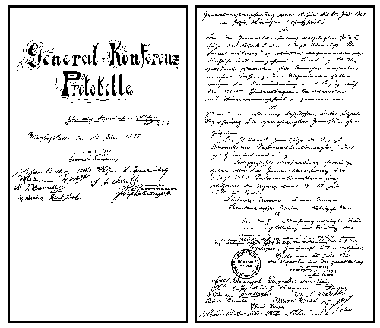The return of the two delegates–Brethren Otto Welp and Heinrich Spanknoebel– from their trip across the Atlantic, in 1922, aroused untold interest and, in some cases, disappointment and perplexity. Through correspondence and personal contacts the news spread from country to country that there were no prospects of reconciliation with the Adventist Church . . . that the door was closed . . . that our two envoys had not even been granted a hearing at the General Conference session in San Francisco. Many of the brethren began to ask themselves: What will be the next step? Prayerful consultations with one another led the representatives of the different groups of SDA Reformers to the conclusion that a general meeting was absolutely necessary.
1922 – Second International Conference (Bebra, Germany)

A second international meeting of Reformers took place at Bebra, west of Eisenach, Germany, in the summer of 1922. Four Unions that had already been organized agreed to unite into a General Conference and work together. Sabbath School quarterlies, Week of Prayer magazines, and other publications had been put out locally according to the possibilities of the brethren in each country. But now the need was felt to centralize the preparation and dissemination of these materials through the General Conference office in Wuerzburg, Germany. This office became the coordinating link among the different Unions and the center from which attention would be given to new interests and new groups that should be aroused by the message of reformation in many other places in the world. The four Unions committed themselves to support the General Conference work with a tithe of the tithes. Brother Welp was confirmed as president and Brother Spanknoebel as secretary. It was decided that the General Conference would be organized on a definite basis in 1925, and the believers in general were informed of this plan.
1925 – Our First Official General Conference Session
Our first GC delegation session proper was held at Gotha, Germany, July 14–20, 1925, with the presence of 18 delegates. It is from that time that official minutes of our GC sessions have been kept. We still preserve the original minute book as a precious treasure.
When the brethren came together in 1925, the verse in Acts 15:4 could almost be paraphrased as follows: “And when they were come to Gotha, Germany, they were received of the church and of the elders who had organized the conference, and they declared all things that God had done with them.” Their reports confirmed again the fact that the reform-minded brethren in several countries had gone through similar experiences. But every heart seemed to be worried over the question: How far are we united in doctrine? All were genuine Seventh Day Adventists. All professed to be Reformers. All upheld the truth as revealed in the threefold message of Revelation 14. There was no doubt as far as the general tenets of Adventism were concerned. But coming down to minutiae–to the understanding and application of certain principles–it could not be said that they were all “joined together in the same mind and in the same judgment” (1 Corinthians 1:10). Far from that. And then there were different ideas with reference to the proposed organization and everything that goes with it. Amid the apparent confusion of concepts, however, there seemed to shine a ray of hope for a better future.

The points of harmony–where all could see things eye to eye–were explored in the first place. All shared the conviction that sincere and orderly efforts had been made to bring about a genuine and God-approved reconciliation with the church that they loved. All were of the opinion that it would be useless to try again, since there was no evidence that the serious errors which lay at the basis of the discussion at Friedensau, 1920, had been or would ever be removed. They had no hope that the needed reformation would ever come “within the church.” All felt that they were going through the experience of their predecessors in the work of reformation. History, which has a tendency to repeat itself, and which is a textbook of pattern procedures, held out an important lesson for them as follows:
“When the Reformers preached the word of God, they had no thought of separating themselves from the established church; but the religious leaders would not tolerate the light, and those that bore it were forced to seek another class, who were longing for the truth. . . . Often those who follow in the steps of the Reformers are forced to turn away from the churches they love, in order to declare the plain teachings of the word of God. And many times those who are seeking for light are by the same teaching obliged to leave the church of their fathers, that they may render obedience.”–The Desire of Ages, p. 232.
“The work of God in the earth presents, from age to age, a striking similarity in every great reformation or religious movement. The principles of God’s dealing with men are ever the same.”–The Great Controversy, p. 343.
Thus, when our first delegation session proper was convened, our pioneers in the work of reformation were already convinced that God demands unity “upon a true, scriptural basis,” not unconditional affiliation. This principle, exemplified by our forefathers in the faith, was clear to them:
“To secure peace and unity [our forefathers] were ready to make any concession consistent with fidelity to God; but they felt that even peace would be too dearly purchased at the sacrifice of principle. If unity could be secured only by the compromise of truth and righteousness, then let there be difference, and even war.”–Ibid., p. 45.
“Christ calls for unity. But He does not call for us to unify on wrong practices. . . . He does not gloss over wrongdoing with a coat of untempered mortar.”–Selected Messages, bk. 1, p. 175.
Our delegates in 1925 did not have the Fundamental Principles of SDAs published in 1872, but they had the book Bible Studies for the Home Circle, which was based on that publication of 1872. They did not believe in establishing a creed but, for the sake of ensuring uniformity in teaching and practice, they deemed it necessary to adopt a set of principles based on the material available to them, from the Seventh-day Adventist Church. They did their best, according to their knowledge and understanding. This is how our humble booklet Principles of Faith came into existence. Resolution No. 10 reads:
“The principles of the Seventh Day Adventist Reform Movement submitted to the General Conference were adopted after examination and detailed deliberation. Seventeen delegates voted for their adoption in their original form. One delegate had objections because of the formulation with reference to the 144,000. The principles were accepted by the majority.”
To us as a Movement the Principles of 1925 have ever been a symbol of unity in the faith.
When this step of prime importance was settled, there was a secondary step which also involved some discussion, namely, the organization of the Reform Movement. Most of those 18 delegates (representing 4,000 members) felt that the fundamental truths of the threefold message could not be successfully promoted without a concrete form of organization. Some were opposed to this idea, but their objections did not prevail.
This was the first reason presented in favor of organization: From the very beginning, every true reformation has had to face opposition. The apostles had a struggle with disorderly elements. Luther and Melanchthon contended with them. The early Adventists fought them. And, certainly, this Reform Movement would be no exception. For the purpose of keeping out impostors and for several other purposes (Testimonies to Ministers, p. 26), a definite form of organization was considered necessary. And it was understood that this organization should be built on the same platform which had been established by the Advent pioneers and strengthened by the distinctive doctrines of the Advent Movement, but separate from the organization of the Adventist mother church; for, “How can two walk together lest they be agreed?”

The official name to be adopted by the Reform Movement was another matter of discussion among the delegates. The representatives of the work in Germany proposed that their name, International Missionary Society, registered in 1919, should be accepted for the Reform church as a whole. The majority had a different idea. The main objection was that many other societies, such as the so-called Jehovah’s Witnesses, were using the name “International.” The delegates wanted a name that would not cause unnecessary confusion with other societies. And, after a lengthy discussion, they finally agreed to adopt the name (Resolution No. 11) that we have carried until today.
The meeting of 1925 paved the way for a worldwide movement. At this session the Principles of Faith were adopted, four Union Conferences joined to form a General Conference, and the name of our organization was agreed upon, as shown in the General Conference minutes of 1925 and on the front cover of the booklet Principles of Faith published immediately afterwards in Germany:
The Principles of Faith of the Seventh Day Adventist Reform Movement and their Rules of Church Order–Concise Presentation published by the General Conference of the Seventh Day Adventist Reform Movement during the General Conference session held in Gotha (Germany), July 14–20, 1925:
German Union: Wuerzburg (Germany)
Danube Union: Sofia (Bulgaria)
Scandinavian Union: Copenhagen (Denmark)
Baltic Union: Revel (Estonia)
The Principles of Faith in German carried also the address of each Union Conference.
For the first term Otto Welp was elected president and Willi Maas secretary.

